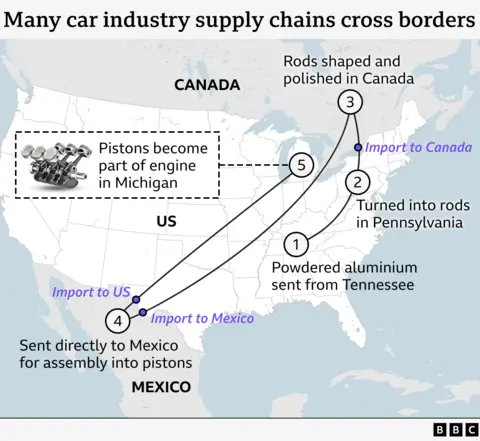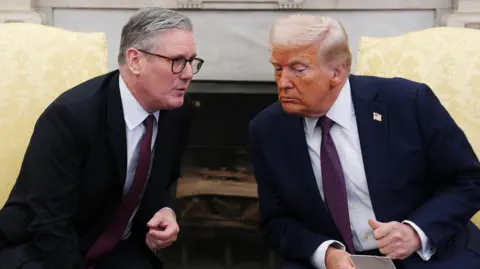US President Donald Trump is set to announce further tariffs on 2 April, which he has suggested will hit all countries.
He has already introduced a series of taxes covering steel, aluminium and car imports as well as all goods from China.
Trump argues the measures – which make foreign goods more expensive – will help US manufacturers and protect jobs. However, prices could go up for consumers.
What are tariffs and how do they work?
Tariffs are taxes charged on goods imported from other countries.
Typically, tariffs are a percentage of a product’s value. For example, a 25% tariff on a $10 (£7.76) product would mean an additional $2.50 charge.
Companies that bring the foreign goods into the country have to pay the tax to the government.
Firms can choose to pass on some or all of the cost to customers.
 Getty
GettyWhy is Trump using tariffs?
Tariffs are a central part of Trump’s economic vision. He says “tariff” is his favourite word.
He argues the taxes will encourage US consumers to buy more American-made goods, boosting the country’s economy and increasing the amount of tax raised.
Trump wants to reduce the gap between the value of goods the US imports and those it exports to other countries.
For example, the US had a trade deficit of $213bn (£165bn) with the European Union (EU) in 2024, something Trump has called “an atrocity”.
The US president also said tariffs were intended to force China, Mexico and Canada – the countries first targeted – to do more to stop migrants and drugs reaching the US.
He has refused to rule out the possibility of a recession as a result of his trade policies. US Commerce Secretary Howard Lutnick said tariffs were “worth it” even if they led to an economic downturn.
Several tariffs announced by Trump have subsequently been delayed, amended or scrapped.
Will prices go up for US consumers?
Economists expect tariffs to increase prices for US consumers across many imported goods, as firms pass on some or all of their increased costs.
The products affected could include everything from beer, whisky and tequila to maple syrup, fuel and avocados.
Firms may also decide to import fewer foreign goods, which could in turn make those which are available more expensive.
Among Trump’s targets are overseas car firms. The US imported about eight million cars last year – accounting for about $240bn (£186bn) in trade and roughly half of overall sales.
The new import taxes of 25% on cars and car parts will take effect on 2 April, with charges on businesses importing vehicles starting the next day. Taxes on parts are due to kick in later, possibly in May.
Car prices were already expected to rise as a result of tariffs on imports from Canada and Mexico.
Component parts typically cross the US, Mexican and Canadian borders multiple times before a vehicle is completely assembled.

The cost of a car made using parts from Mexico and Canada alone could rise by $4,000-$10,000 depending on the vehicle, according to analysts at the Anderson Economic Group.
The tariffs Trump announced during his first term as president raised the average price of steel and aluminium in the US by 2.4% and 1.6% respectively, according to the US International Trade Commission.
US tariffs on imported washing machines between 2018 and 2023 increased the price of laundry equipment by 34%, according to official statistics.
Prices fell once the tariffs expired.
What tariffs has Trump announced?
2 April:
- 25% tariff on cars coming into the US – 25% tariff on imported car parts due in May or later
12 March:
- 25% tariff on all steel and aluminium imports
6 March:
- Tariff exemption expanded to include other goods shipped under North America’s free-trade agreement, such as televisions, air conditioners, avocados and beef
- Tariffs on potash – used in fertiliser by US farmers – reduced from 25% to 10%
5 March:
- A month-long tariff exemption announced for cars made in North America which comply with the continent’s existing free trade agreement
4 March:
- 10% tariff on Chinese goods doubled to 20%
- 25% tariff against goods from Mexico and Canada, with a 10% tariff on Canadian energy imports
7 February:
- Exemption for shipments from China worth less than $800
4 February:
- 10% tariff on goods from China
How will Trump’s tariffs affect the UK?
 PA Media
PA MediaHow have other countries responded to Trump’s tariffs?
A number of other countries have introduced their own tariffs on goods imported from the US.
These will make US products more expensive, and are bolstering fears of a global trade war which could create problems for economies worldwide.
China has introduced a 10-15% tax on some US agricultural goods. It has also targeted US aviation, defence and tech firms.
EU tariffs targeting US goods worth €26bn (£22bn) will start on 1 April and be fully in place on 13 April. They will cover items ranging “from boats to bourbon to motorbikes”, as well as steel and aluminium products.
Canada has imposed 25% tariffs on US steel, aluminium and a range of other goods. Further counter tariffs may be introduced on 2 April.
Mexico has delayed introducing its own retaliatory tariffs while negotiations continue.
Read full article at source
Stay informed about this story by subscribing to our regular Newsletter




